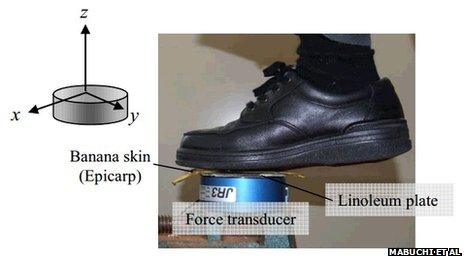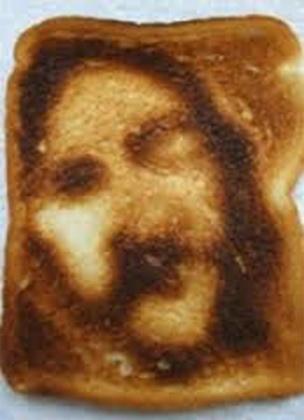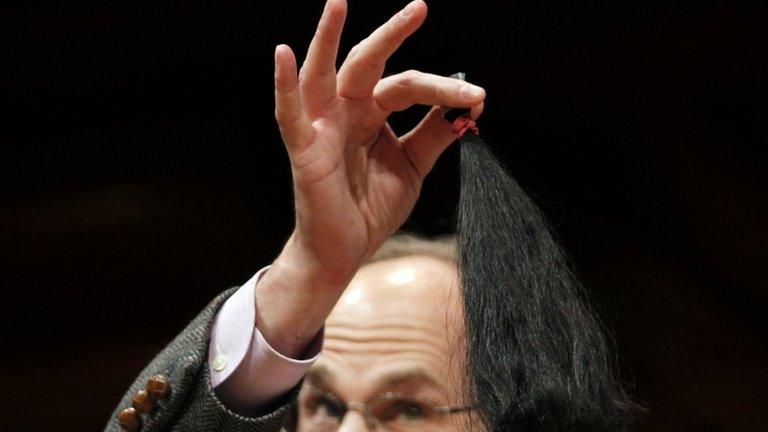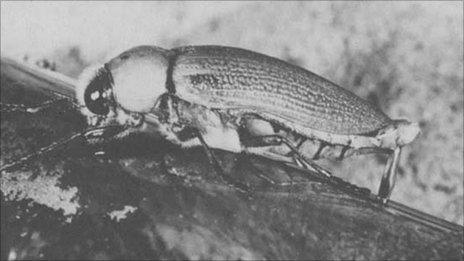Slippery banana study wins Ig Nobel
- Published

Research that investigated why bananas are slippery when you step on them has won one of this year's Ig Nobel prizes.
The spoof awards that have become almost as famous as the real Nobels were handed out at their annual ceremony, external at Harvard University, US.
Kiyoshi Mabuchi's Japanese team measured the friction of banana skin in the lab, external, and showed why apple and orange peel are not quite so hazardous.
The Kitasato University group received the physics Ig for their insights.
It is another classic of its type. The awards, which are run by the science humour magazine Annals of Improbable Research, external, can seem quite ridiculous at first.
But when you delve deeper, you often see a serious intention beyond just the tongue in cheek.
The Japanese scientists are interested in how friction and lubrication affect the movement of our limbs.
The polysaccharide follicular gels that give banana skins their slippery properties are also found in the membranes where our bones meet.
"This concept will help to design a joint prosthesis," Kiyoshi Mabuchi told BBC News.

In their paper, the Kitasato group describes its experimental set-up
Another winner this year was the study that examined the brains of people who see the face of Jesus, external and other figures in slices of toast. The work won the neuroscience Ig.
Kang Lee, from the University of Toronto, Canada, and colleagues showed their subjects pictures of "noise" - like the random speckles you used to get on old, out-of-tune TVs - to see what patterns the volunteers would identify.

The face of expectation: Jesus on toast
This tendency to see order in randomness - like a face in the charred areas of a piece of bread - is a well-established phenomenon called pareidolia.
Using Functional Magnetic Resonance Imaging, Lee and his team saw how the same parts of the brain light up when we see non-existent faces as when we see real ones.
"Interestingly, when you superimpose all the noise images where these people say they see faces, and subtract all the noise images in which they told us they couldn't see faces - when we do this type of image processing, a face does actually show up," Prof Lee said.
The Toronto scientist explained that this type of pattern recognition was hard-wired, and even chimps experienced it.
"The face you are going to see is determined by your personal expectations or beliefs," he added.
"So, for example, Buddhists might not see Jesus on toast, but they might see a Buddha on toast."
This is the 24th year of the Ig Nobels, external, and they just get bigger and bigger.
Marc Abrahams, the editor of Annals of Improbable Research, said scientists were clearly now doing studies with an eye to winning an Ig.
"We're getting about 9,000 nominations a year. About 10% to 20% are self-nominations, but these entries hardly ever win," he told BBC News.
"That's generally because they are just trying to be funny. Whereas, those who win perhaps don't start out that way, and only realise later on that what they are up to really is kind of funny."
The full list of winners this year:
PHYSICS: Kiyoshi Mabuchi, of Kitasato University, Japan, and colleagues, for measuring the amount of friction between a shoe and a banana skin, and between a banana skin and the floor, when a person steps on a banana skin that's on the floor.
NEUROSCIENCE: Kang Lee, of the University of Toronto, Canada, and colleagues for trying to understand what happens in the brains of people who see the face of Jesus in a piece of toast.
PSYCHOLOGY: Peter Jonason, of the University of Western Sydney, Australia, and colleagues for amassing evidence that people who habitually stay up late are, on average, more self-admiring, more manipulative, and more psychopathic than people who habitually arise early in the morning.
PUBLIC HEALTH: Jaroslav Flegr, of Charles University, Czech Republic, and colleagues for investigating whether it is mentally hazardous for a human being to own a cat.
BIOLOGY: Vlastimil Hart, of the Czech University of Life Sciences, and colleagues for carefully documenting that when dogs defecate and urinate, they prefer to align their body axis with Earth's north-south geomagnetic field lines.
ART: Marina de Tommaso, of the University of Bari, Italy, and colleagues for measuring the relative pain people suffer while looking at an ugly painting, rather than a pretty painting, while being shot [in the hand] by a powerful laser beam.
ECONOMICS: The Italian government's National Institute of Statistics, for proudly taking the lead in fulfilling the European Union mandate for each country to increase the official size of its national economy by including revenues from prostitution, illegal drug sales, smuggling, and all other unlawful financial transactions between willing participants.
MEDICINE: Ian Humphreys, of Michigan State University, US, and colleagues, for treating "uncontrollable" nosebleeds, using the method of nasal-packing-with-strips-of-cured-pork.
ARCTIC SCIENCE: Eigil Reimers, of the University of Oslo, Norway, and colleagues, for testing how reindeer react to seeing humans who are disguised as polar bears.
NUTRITION: Raquel Rubio, of IRTA, Spain, and colleagues, for their study titled "Characterization of Lactic Acid Bacteria Isolated from Infant Faeces as Potential Probiotic Starter Cultures for Fermented Sausages."
Jonathan.Amos-INTERNET@bbc.co.uk and follow me on Twitter: @BBCAmos, external
- Published13 September 2013

- Published21 September 2012

- Published30 September 2011

- Published1 October 2010